How I would design a fun offense around Rocky Lombardi
Assuming of course he wins the quarterback job . . .
“There are many ways to skin a cat,” is, foremost, a really weird saying that I’m uncomfortable with the origins of. Nobody should be skinning cats. Second—and for the sake of this post most importantly—it’s also a PERFECT way to describe offense in college football.
For me, the absolute best thing about college football is that there are so many ways of going about it. The game has everything from the Double wing Triple Option offense to the Leach Air Raid and everything in-between and they all have had great moments of success. It’s truly the best.
With the Big Ten giving the green light to football, that has gotten fans of Michigan State back to focusing on the questions around the 2020 team on the field. First on most people’s minds is the quarterback. Who is going to start at quarterback? It’s tough to know right now, mostly because Michigan State hasn’t practiced yet, but I’m thinking it’s going to be Rocky Lombardi from the jump. This is tea leaf reading, but Lombardi has been the most present face among the QBs this offseason. MSU did a little social media event a couple weeks ago where they had Lombardi play against Northwestern in the NCAA 14 video game and they posted pictures, videos and all that. Lombardi has been prominently featured in pictures and videos from the Spartans’ abbreviated fall/summer camp. He has met with the media multiple times. You get it.
He’s also the most experienced QB of the bunch and in a weird offseason like this, that might be enough to win the day. Taking those assumptions as fact—which I’m not totally locked into doing, but I think is the most likely route—the next question is then what does the offense look like around him? Both Mel Tucker and offensive coordinator Jay Johnson have said they like their offense to be “multiple,” which is a fun coach buzzword that doesn’t mean much other than they want to be able to do different things. Judging by the history of Johnson as a play caller, he seems pretty flexible. At Louisiana he had a very mobile QB during their best seasons and thus a lot of designed QB runs were called. Same goes for his year at Minnesota. Last year at Colorado the Buffs started Steven Montez at QB, who is decidedly not mobile. So Johnson switched it up and QB run was minimized from the offense. So I think the offensive staff will truly aim to work with what they have and not force a round peg square hole situation. That’s good.
A thing I like to say is that college football is wonderful because it’s a bunch of really talented football players who don’t yet know how to play football. What I mean by that is that on the grand scale of football, these guys are juuuust scratching the surface. Every weekend in college football there are a number of magical, talent-filled plays and plays during which you would swear the participants have never played football before. It’s a sweet spot where talented players with glaring flaws can thrive. The NFL is too good. Flaws get weeded out in the NFL. But not in college. In college a coach can design an offense around whatever they’ve got and it can work (remember the skinning cat situation up top). In college a very talented player who can’t throw a football can become a two-time national champion, win the Heisman, and go down as one of the all-time greats. It’s just the best. This is the angle from which I want to approach building an offense around Rocky Lombardi.
Rocky Lombardi is a flawed football player. I hope I’m not breaking any news on that front. Through his two years—in a limited sample size—Lombardi has completed just shy of 43% of his passes for a downright paltry 4.6 yards per attempt and three TDs against five picks. And one of those TDs came on a jet shovel pass that Speedy Nailor took 48 yards for the score. Him dropping back has been rough, but it certainly hasn’t been all his fault in that department. As a redshirt freshman he was asked to do things he didn’t have the ability to do, behind a makeshift line with injured receivers by a staff that took a hammer to his and Brian Lewerke’s psyche during the great quarterback bungle of 2018. I still can’t believe that happened. Not to mention his 2019 action was in mop-up blowout duty against Wisconsin, AKA “Let’s get the fuck out of here,” mode and against Penn State, also in blowout duty, during a driving rainstorm. So I take his numbers with a grain of salt, as should you.
Now, that doesn’t mean his passing has been good. It hasn’t. It has been bad. He’s always struggled with accuracy. His pocket management leaves a lot to be desired and his mechanics tend to fall apart during games.
With all of that said, I’m still quite confident a very fun—and effective—offense could be built around him. Let me tell you why and how.
First things first; Rocky Lombardi’s right arm is a goddamn cannon. He has a fucking howitzer. Perhaps his biggest weakness as a passer is that he has little control over said arm. So, I ask, why try to control it? More on that later.
NEXT. Lombardi is a very capable runner. He’s a former state champion wrestler and is built like it. He runs with power, which can be seen in these runs from the Purdue game during his freshman season.
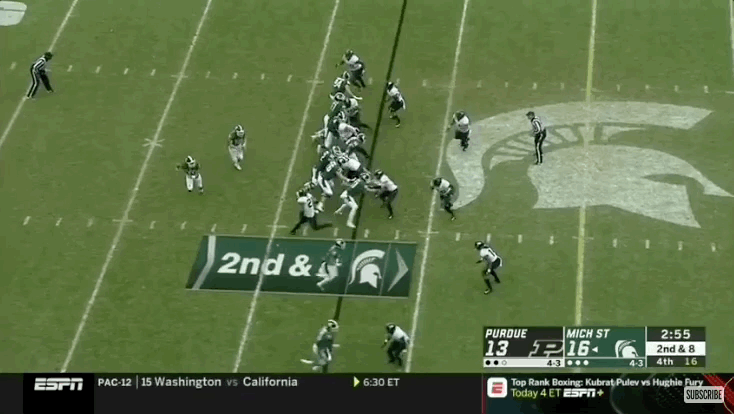
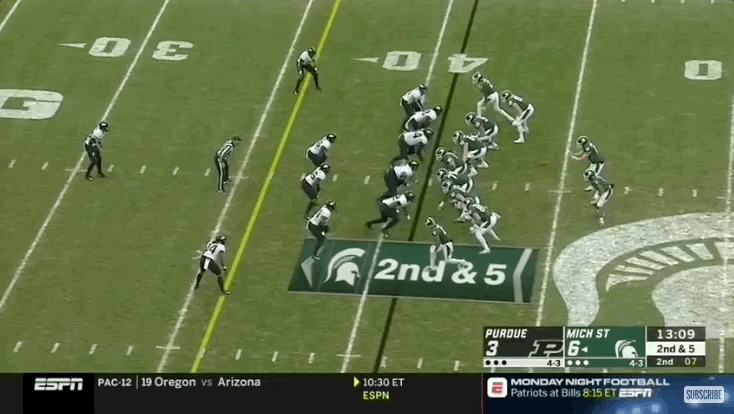
Imagine him running in an offense where the play calling for designed QB runs is more creative than “speed option left,” “speed option right,” or “QB sneak.”
There are legitimate football skills in his game. Building an offense around them shouldn’t be too hard. In fact, I’m really only going to look three places, Gainesville, Florida from 2006-09, Manhattan, Kansas from 1989-now because dear God Bill Snyder has been doing this a looooong time, and wherever the hell Mike Leach is roaming around these days. The offense will be option-base, with QB run as a staple, and a deep, simple passing game.
(I’m going to talk a little bit about Urban Meyer’s offense at Florida with Tim Tebow at QB. Please don’t think I’m directly comparing the situations or thinking the results would be similar.)
Tim Tebow is—as alluded to earlier in the post—the supreme A1 version of, “Look at this incredibly flawed player that nobody can stop,” that college football has to offer. He couldn’t throw to save his life and still can’t and never will, but did that stop him from becoming one of the most dominant college football players ever? Nope. Now, Lombardi won’t ever become that, and he’s about 20 pounds shy of Tebow’s college weight, but how Meyer built his offense at Florida around his janky-throwing lefty is a good source of inspiration. Plus, I’m going to steal a bunch of his plays, because they’re great.
While it may have seemed revolutionary, what Meyer did at Florida (and in previous stops and at Ohio State) was really just old, old-school option football. All Meyer did was make it look prettier. He took the fullback and made him a speedy tailback. He took the wingbacks and moved them out wide and into the slot. He told the quarterback to stand a few yards further back and bada bing bada boom; The Urban Meyer offense. (That’s not to discredit Meyer, because coaching isn’t just having good scheme. Good coaches are the ones that are able to get the players to properly execute said scheme. Every offensive play is designed to work. Not all of them do.)
Anyway, the offense I would build around Lombardi would be based on a lot of option plays. I’d start there for a few reasons.
Option plays are always going to help the offense get a numbers advantage because the threat of the QB run.
I’m a huge fan of what option plays can do to set up the deep passing game because they put so much stress on defensive backs in run support.
They work.
These next few plays are all from Meyer’s Florida offense. They probably look familiar in a couple ways. You may have run them or something similar in high school. You probably watched Tim Tebow shred the world for three years with these very plays.

I also think Michigan State’s offense has really good personnel for these types of plays. You’ll notice that with the offensive line in these diagrams, a lot of the work is done pre-snap with well-thought-out angles. There are multiple defenders getting “blocked” by being the option reads, and that allows linemen to get better angles on the guys they need to actually get their hands on. MSU also has a number of speedy backs and slot receivers that would do really well in these plays. Imagine that first play with Eli Collins on the counter run with Speedy Nailor as the pitch man. Anthony Williams Jr. and Jayden Reed could do some damage here as well.
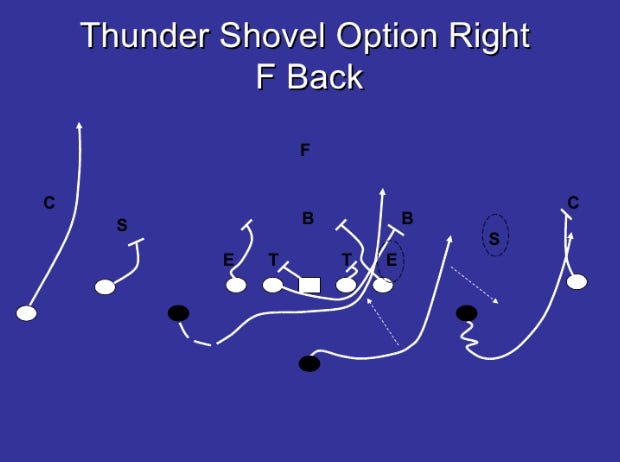
This is a play that used to go to Aaron Hernandez a ton, but it could also go to a receiver lined up in tight. These are simple plays that put defenders in tough spots and take advantage of Lombardi’s running ability as well as the skills of the talent around him.

QB power absolutely should be a part of whatever is run with Lombardi under center. He’s listed at 6’4 and 225 pounds and he is going to be just as big, if not bigger, than a lot of guys trying to tackle him. He can run between the tackles.
This next play is a QB Iso play straight from he Bill Snyder playbook at Kansas State. Nobody has a better track record of taking flawed but capable quarterbacks and getting them to produce than Snyder. (There is a very soft spot in my heart for Collin “Optimus” Klein)
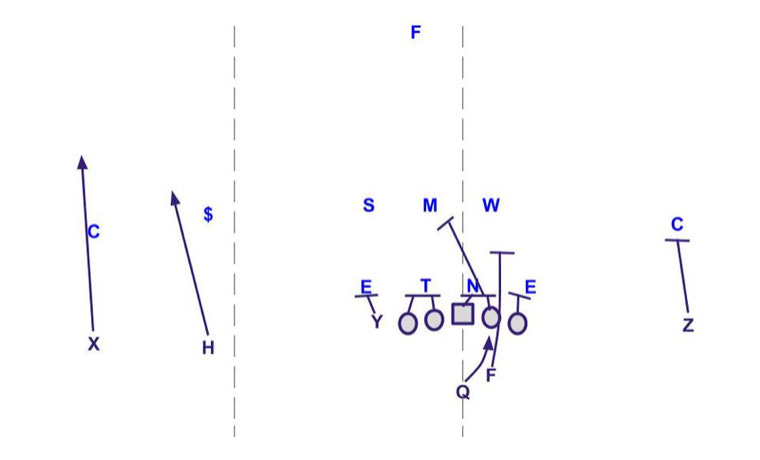
Michigan State has technically removed the fullback from the offense (nobody on the official roster is listed as a fullback) but there are still fullbacks on the team. Max Rosenthal is listed as a tight end, but trust that when he is on the field he will be serving some H-back/fullback-type role. This play is just old-fashioned gap running with the added element of a QB run to create a numbers advantage. People like to say of Bill Snyder that he never shows up to the dance without a +1, referencing his love of the QB run and what it does for the arithmetic of football. I’d use that mindset when building an offense around Lombardi.
This specific Iso play has a tremendous RPO tag on it too that K-State started using a few years back. Instead of blocking, the fullback dodges the linebacker and turns for a pop pass. The QB reads that linebacker and it’s one simple read. If the backer goes with the pass, run it. If the backer fills the hole, throw the pass.
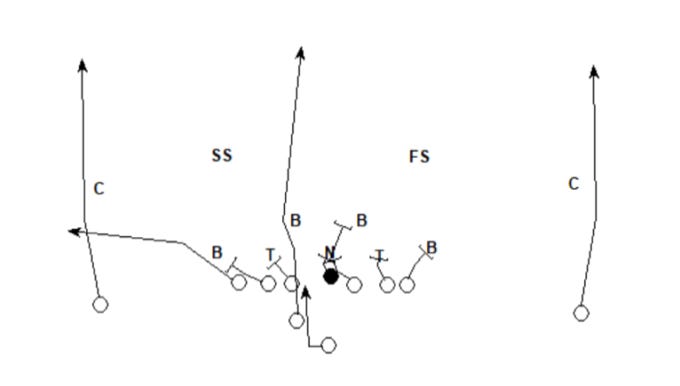
All of the other routes in this play are designed to pull defenders deep and to the sidelines. There is only one read. Super simple, yet effective. The same concept can be run from spread formations too, which naturally creates the horizontal spacing in the defense. It can also be run with an H-back or tight end running the route on a QB dive play action.
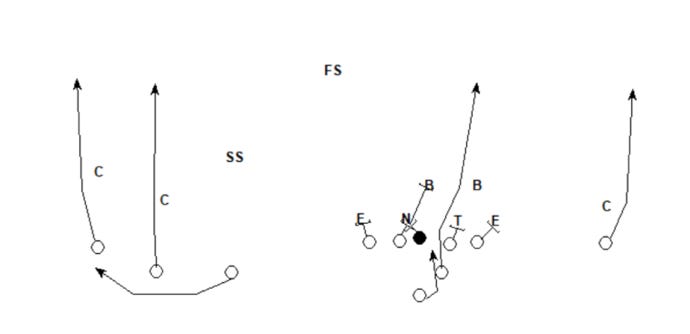
Perhaps the best part about all of these plays is that they are all flexible. They can be run from a bevy of different formations with different personnel groupings. That allows for a creative play caller to use down and distance to his advantage. In run downs he can make it look like a run and then out of nowhere, here comes a QB pop pass. And it doesn’t just have to be the “Iso” play. Any run concept can work here. The keys are having that QB tilt the numbers in the favor of the offense and providing simple reads to get the ball into the hands of the talented backs on receivers on this offense.
As for the passing game, we’ll look to the Mike Leach Air Raid for some inspiration. We will start with four verticals. All streaks. Whatever you want to call it. Lombardi has that incredibly strong arm as mentioned above . . . we should probably use it. This is the Mike Leach four verts concept, which he calls “6” because it scores touchdowns. You’ll notice that instead of just straight vertical routes across the board, different receivers have different options built into the routes. That is because, depending on what the defense is doing, receivers have the option to break off their routes at different spots.
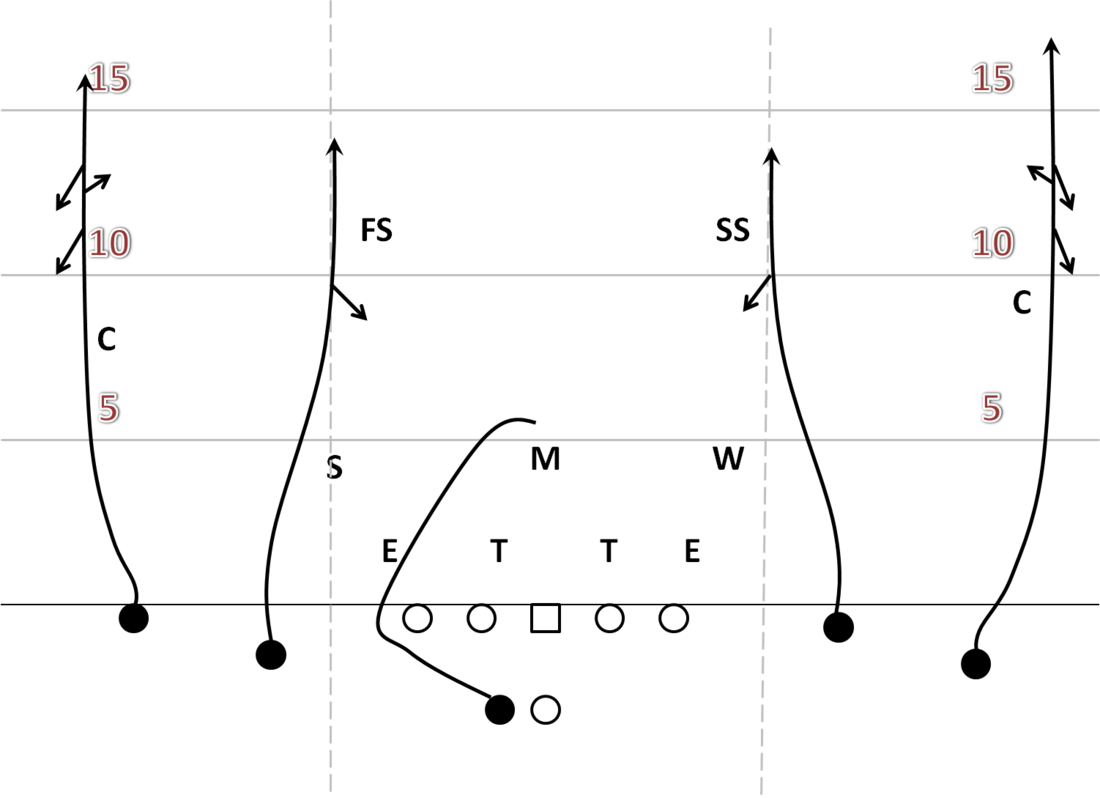
I don’t want to crap on the likes of Graham Harrell and Cliff Kingsbury, but Mike Leach has used this play to roll up gobs of deep passing touchdowns with some less-than-stellar quarterbacks. It takes some time to perfect, but it is the most effective deep passing play in college football. Pick a guy, look at his defender and throw it to where he is not. Simple.
I’m also going to find other concepts to push the ball vertically. Baylor used to do something similar to the above four verts play, but they simplified it even more. Baylor would “tag” a receiver as the primary option in a deep passing play. That receiver would then have the option to run a handful of deep routes based on the coverage. The receiver next to him ran a route specifically to help that receiver get open and the receivers on the other side of the field did nothing. They just stood there. It was literally, “Hey, go deep and find some space,” and the quarterback would just throw it to that receiver. One read, one throw. Easy and—as MSU fans can attest to—incredibly effective.
I’m also going to use a TON of play action in the deep passing game. Like I mentioned above, when defensive backs have big responsibilities in the run game—like those presented in an option attack—throwing over their heads gets a lot easier. Michigan State’s safeties under Mark Dantonio got thrown deep on a ton because they had very important run-stopping responsibilities. Play action makes winning that conflict even harder on DBs.
Aside from the vertical passing game I’m going to run a bunch of passing plays that are easy to throw, easy to read and have natural separation. By now you all know about rub routes, where a receiver uses his route to create a natural pick for another receiver. Yeah, we’re doing that a ton. We’re also going to run a bunch of crossers and mesh, another couple of Air Raid staples. Why more teams don’t run crossers and mesh to death I don’t understand.
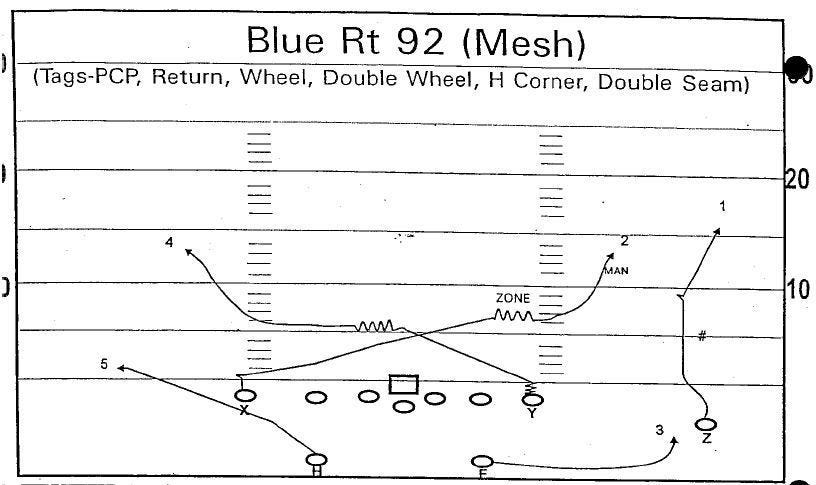
Mix in with that a bunch of RPO tags on the base running plays and we’re looking at a pretty good offense. Of course I’d include a couple of plays which are going to actually be a part of the new MSU offense, inside zone, outside zone, and their respective zone read plays, all of which can be tagged with pass plays to create RPOs.
Lastly, I’m going to toss in a lot of “eye candy.” pre-snap motion, shifts, etc. I want to try and create as much indecision in the defense before the snap as I possibly can.
There you have it. That’s the offense. Spread, shotgun option football, with some QB power plays mixed in. Tag a bunch of stuff with RPOs and create a passing game that is vertical and has simplified reads. Run it with the numbers advantage and then chuck it deep. Let’s go, baby.
What I’m not going to do ever is run a pass concept that asks Lombardi to throw with great precision or timing, like he was asked to do previously at MSU. Unless his throwing has developed a ton, that’s just not his game and asking him to do that is insane. I’ve said for years that Michigan State’s offense makes life unnecessarily hard on the quarterback. Full-field reads are hard. Toss ‘em. Corner routes are hard. Toss most of ‘em. Deep outs and comebacks are hard. Toss ‘Em. Far hash throws are hard. Toss ‘em. Wide fades are hard. Toss ‘em. Plays that require throwing between zones to the sideline are hard. Toss ‘em.
Now, I think very few of these plays will actually make their way into MSU’s playbook. If you’re asking me what I think the offense is most likely to look like under Lombardi, I’d say there will be a lot of inside and outside zone with some quarterback run and man-beater passing concepts. With a lot of QB run, MSU will probably face a bunch of zone defense, so Lombardi will have to throw with some precision at some point. Taking the top off of that zone would be incredibly helpful in accomplishing that. I'd hope the vertical passing game would be a focus because of Lombardi’s arm strength. We’ll see. As I said up top, Johnson has shown flexibility in the past and he and Tucker have talked at length about how they want to be multiple. A quarterback with Rocky Lombardi’s skillset provides them a chance to do just that.
And hopefully they don’t skin any cats along the way.


Could Theo Day and Payton Thorne could use this same offense with minimal changes? Who is likely more mobile/stronger runner between those two?